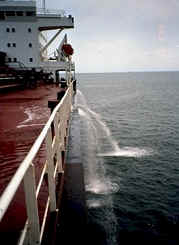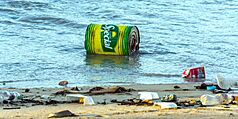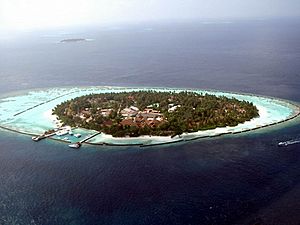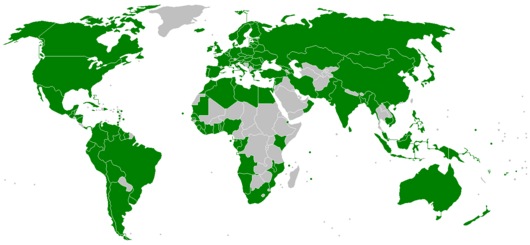Marine pollution facts for kids

Marine pollution happens when harmful things made or used by humans get into the ocean. These can be waste from factories, farms, or homes. They can also be tiny particles, loud noise, extra carbon dioxide, or even new species that don't belong.
Most of this pollution (about 80%) comes from land. It travels to the ocean through rivers, sewage systems, or even by wind. Ships also add to ocean pollution. This mix of chemicals and trash harms the environment, the health of all living things, and even economies around the world.
Because most pollution starts on land, areas close to the coast, like continental shelves, are most affected. Even Air pollution can reach the ocean, carrying things like nitrogen, pesticides, and dust. Pollution often comes from many different places, like rainwater runoff from farms or debris blown by the wind.
The main types of marine pollution include marine debris (trash), plastic pollution (especially tiny microplastics), ocean acidification (when the ocean becomes more acidic), nutrient pollution (too many nutrients), toxic chemicals, and underwater noise.
Plastic pollution is a big problem. It includes everything from large bottles and bags to tiny pieces called microplastics. These microplastics form when bigger plastic items break down. All this plastic is very bad for marine life.
Another issue is too many nutrients, like nitrogen and phosphorus, from farms and untreated sewage. These nutrients act like fertilizer for tiny ocean plants called phytoplankton and larger algae. This can cause huge algal blooms, also known as eutrophication. These blooms can harm both marine animals and humans. Too much algae can also cover and damage sensitive coral reefs, leading to a loss of different species. When these large algal blooms die, they use up a lot of oxygen in the water, creating "dead zones." This problem might get worse with climate change as warmer waters mix less.
Many toxic chemicals stick to tiny particles. These particles are then eaten by small ocean creatures like plankton and bottom-dwelling animals. This means the toxins move up the food chain and become more concentrated in bigger animals. Pesticides and Toxic metals can cause health problems, changes in behavior, and affect the reproduction and growth of marine life. These toxins can even end up in the food we eat, like meat and dairy products, if land animals eat fish products containing them.
Contents
How Pollution Reaches the Ocean
Pollution enters the ocean in several ways. The three main paths are:
- Directly releasing waste into the ocean.
- Water flowing from land into the ocean after rain (called runoff).
- Pollutants falling from the air into the ocean.
Rivers are a common way for pollution to reach the sea. Rain falls on land, flows into rivers, and then carries many things into the ocean.
Pollution can be either "point source" or "nonpoint source."
- Point source pollution comes from one clear, identifiable place. An example is a pipe directly releasing sewage or factory waste into the ocean. This type of pollution is easier to track.
- Nonpoint source pollution comes from many different, spread-out places. This can be harder to control. Examples include rainwater runoff from farms or trash blown by the wind.
Directly Releasing Waste
Pollutants can enter rivers and the sea directly from city sewerage systems and industrial waste discharges. Sometimes this waste includes dangerous chemicals or plastics.
Many countries contribute to plastic pollution in the ocean. Studies show that a large amount of plastic waste comes from several nations, especially those with large coastal populations.
Even mining for metals like copper and gold on land can cause marine pollution. Much of this pollution is soil that washes into rivers and then to the sea. Some minerals from mining, like copper, can harm the life cycle and development of coral polyps. Mining has often caused environmental problems, with much of this pollution eventually reaching the ocean.
Pollution from Land Runoff
Surface runoff is water from rain or melting snow that flows over land. This water can pick up soil and tiny particles containing carbon, nitrogen, phosphorus, and other minerals from farms, cities, and construction sites.
This nutrient-rich water can cause huge growths of algae and phytoplankton in coastal areas. These are called algal blooms. They can use up all the available oxygen in the water, creating low-oxygen conditions. This is harmful to marine life. For example, in southwest Florida, harmful algal blooms have caused fish, turtles, dolphins, and shrimp to die. They can also make humans sick if they swim in the water.
Polluted runoff from roads and highways is another big source of ocean pollution. For instance, about 75% of the toxic chemicals in Puget Sound come from stormwater runoff from paved roads, rooftops, and yards. In California, winter rainstorms carry petroleum, heavy metals, and other pollutants from car emissions into the ocean.
Coastal areas with large populations, like in China, also contribute to ocean pollution through land runoff. This includes sewage and pollution from growing cities.
Pollution from Ships
Ships can pollute oceans in many ways. This includes releasing ballast water, bilge water, and fuel.
Oil spills are very damaging. Besides being toxic to marine life, the chemicals in crude oil are hard to clean up and can stay in the sediment and ocean for years. Bilge water, which collects in the bottom of a ship, can also be toxic if released.
While large tanker accidents get a lot of attention, much of the oil in the sea comes from smaller sources. These include tankers cleaning their oil tanks, leaking pipelines, or engine oil poured down drains.
Ships also sometimes illegally dump cargo residues and other wastes. Some cruise liners have been known to dump waste where rules are not strict. It's estimated that container ships lose over 10,000 containers at sea each year, often during storms. Ships also create noise pollution that can disturb marine animals.
Ballast water is water taken on by ships to help them stay stable. When this water is released in a new port, it can carry unwanted marine life from one part of the world to another. These new species are called invasive species. For example, zebra mussels, originally from the Black Sea, were likely brought to the Great Lakes in ship ballast water. These invasive species can take over habitats, spread diseases, and make it hard for native species to find food.
Pollution from the Air
Pollution can also travel through the air and fall into the ocean. Wind can blow dust and debris, like plastic bags, from landfills and other areas far out to sea.
For example, dust from the Sahara Desert in Africa can travel across the Atlantic Ocean to the Caribbean and Florida. Dust from the Gobi Desert in Asia can also travel across the Pacific Ocean to places like the Hawaiian Islands.
Since the 1970s, dust storms have become worse due to droughts in Africa. Scientists have linked these dust events to a decline in the health of coral reefs in the Caribbean and Florida.
Climate change is also affecting the ocean. Rising global temperatures are warming ocean waters. Also, more carbon dioxide in the air is making the oceans more acidic. These changes are harming aquatic ecosystems and changing where fish live. This impacts fishing communities that rely on the ocean for their livelihoods. Healthy ocean ecosystems are also important for helping to slow down climate change.
Deep Sea Mining Impacts
Deep sea mining involves collecting minerals from the ocean floor. This activity can release potential toxic metals like copper, zinc, and lead. It also increases noise, light, and sediment in the water. These changes can harm deep-sea ecosystems.
Types of Ocean Pollution
Marine Debris
Marine debris is simply human-made trash that ends up in the ocean. This can be anything from plastic bottles and fishing nets to tiny pieces of broken-down materials. It floats on the surface, sinks to the bottom, or is suspended in the water.
This trash is a big problem for marine animals. They can get tangled in it, mistake it for food, or be harmed by the chemicals it releases.
Plastic Pollution
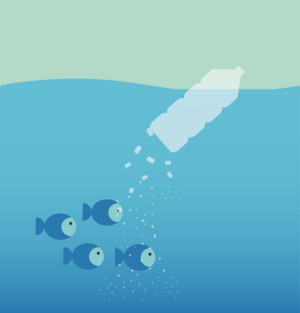
Plastic pollution is a major part of marine debris. It includes all plastics, from large items like bottles and bags to tiny pieces called microplastics. Microplastics are formed when larger plastic items break down over time.
Plastics are very harmful to marine life. Animals can eat plastic, which can block their stomachs or release toxins. Plastic pollution is found in every ocean and on every beach around the world.
Ocean Acidification
Ocean acidification is when the ocean absorbs too much carbon dioxide from the atmosphere. This makes the ocean water more acidic.
This change in acidity makes it harder for marine animals, especially those with shells or skeletons like coral reefs and shellfish, to grow and survive. It can weaken their shells and make them more vulnerable. Ocean acidification is a direct result of increased carbon dioxide in the air, mainly from human activities.
Nutrient Pollution and Algal Blooms
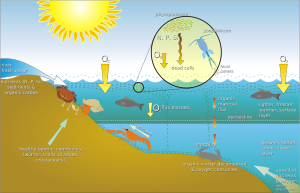
Nutrient pollution happens when too many nutrients, like nitrogen and phosphorus, enter an ecosystem. These nutrients often come from fertilizers used in farming, as well as waste from livestock and humans.
This excess of nutrients causes rapid growth of plants and algae, known as eutrophication or algal blooms. These blooms can be so thick that they block sunlight from reaching other marine plants. When the algae die, their decay uses up a lot of oxygen in the water. This creates "dead zones" where most marine life cannot survive due to lack of oxygen.
Many estuaries (where rivers meet the sea) are naturally rich in nutrients. However, human activities have greatly increased nutrient pollution. The World Resources Institute has identified many hypoxic (low-oxygen) coastal zones around the world. In the ocean, these blooms can cause "red tides" that kill fish and marine mammals. They can also cause breathing problems for humans and pets near the shore.
One idea to help with nutrient pollution is to bring back shellfish populations, like oysters. Oysters filter water, removing nitrogen and other particles. This can help reduce harmful algal blooms and improve water quality.
Industrial Pollution and Toxic Chemicals
Besides plastics, other toxic pollutants are a big problem because they break down very slowly, or not at all, in the ocean. These are called persistent toxicants. Examples include PCBs, DDT, pesticides, and PFAS.
Heavy metals like mercury, lead, and cadmium are also toxic even in small amounts. Some of these toxins can build up in the tissues of marine animals, a process called bioaccumulation. They also collect in places like estuaries and bay muds, leaving a record of human pollution.
DDT was a very toxic chemical used as a pesticide. It was banned in the U.S. in 1972 because it caused health problems and harmed wildlife. However, large amounts had already entered the ocean. DDT moves up the food chain, affecting animals like seals and dolphins, and can cause issues with their reproduction and overall health.
PCBs (polychlorinated biphenyls) are another group of toxic chemicals that were widely used. They were banned in the U.S. in 1976. PCBs build up in the fatty tissues of animals, especially marine mammals like dolphins and killer whales. They can cause serious reproduction problems and weaken the immune system of marine life.
PFAS are a newer group of human-made chemicals that are extremely hard to break down. They are used in many products like firefighting foams and waterproof clothing. Because they don't break down, PFAS have spread throughout the air, land, and oceans. They can harm marine life by slowing the growth of phytoplankton and accumulating in animals like seals and polar bears. Scientists are still studying the full impact of PFAS on ocean ecosystems.
- Specific examples
- High levels of mercury can be found in larger fish like tuna because they eat many smaller fish that have accumulated mercury. Because of this, health organizations recommend that pregnant women, nursing mothers, and children limit how much tuna and other predatory fish they eat.
- Some shellfish and crabs can survive in polluted waters, but they might accumulate heavy metals or toxins in their bodies. If these are harvested for food, careful management is needed to ensure they are safe to eat.
- Pesticides from land runoff can even change the gender of some fish species, turning male fish into female fish.
Underwater Noise Pollution
Marine life can be harmed by noise pollution from sources like passing ships, oil exploration surveys, and naval sonar. Sound travels faster and farther in the ocean than in the air. Between 1950 and 1975, the background noise in parts of the Pacific Ocean increased significantly.
Underwater noise pollution is highest in shipping lanes, port areas, and busy ocean routes. Older and larger ships create a lot of low-frequency noise from their engines and propellers. This constant high noise level is a risk to local ecosystems, especially for animals that cannot easily move away. The overall increase in global shipping has also led to a rise in ocean noise.
The impacts of underwater noise are most serious for marine mammals like whales and dolphins. They rely heavily on sound for communication, navigation, and finding food. Loud noise can disrupt their communication, change their migration paths, and cause stress. For example, endangered whale populations in some areas experience reduced communication ranges. Fish and invertebrates are also affected, with noise causing them to avoid habitats, reduce reproduction success, and disrupt their feeding habits.
Animals sometimes communicate louder to be heard over human-made noise, which is called the Lombard vocal response. Whale songs become longer when submarine detectors are active. If animals cannot "speak" loud enough, their important messages, like warnings or finding prey, might be missed. When one species speaks louder, it can mask the voices of others, causing the whole ecosystem to become louder. Noise can also damage tiny hair cells in important marine organisms like Cnidarians and Ctenophora.
Oceanographer Sylvia Earle has said that underwater noise pollution is like "the death of a thousand cuts." She explains that while each sound might not seem critical, all the noise from shipping, surveys, and military activity together creates a very different environment than before. This high level of noise is sure to have a big impact on life in the sea.
Efforts to reduce underwater noise are ongoing. The International Maritime Organisation (IMO) has released guidelines for quieter ship designs. The European Union also requires countries to assess and reduce underwater noise. Experts believe that a mix of technical solutions and policies, like setting noise limits and creating quiet zones, is needed to protect sensitive ecosystems.
Reducing Ocean Pollution
Much of the pollution created by humans ends up in the ocean. In 2011, the United Nations Environment Programme highlighted the loss of phosphorus (a valuable fertilizer) to the oceans and the impact of billions of pieces of plastic waste as major environmental issues.
Reducing ocean pollution requires two main things: humans polluting less, and finding ways to reduce our "ecological footprint" (the impact we have on the environment). If we don't reduce our impact, the world's ecosystems could suffer greatly.
To pollute less, individuals need to be more aware and respectful of the environment. Regulations and international cooperation are also very important. It's often hard to control marine pollution because it crosses international borders, making laws difficult to create and enforce.
Without enough awareness about marine pollution, it will be hard to get the global effort needed to solve these problems. People need balanced information about where pollution comes from and its harmful effects. Ongoing research is also needed to understand the full scope of the issues.
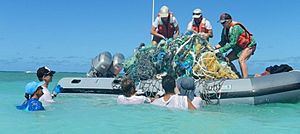
Raising awareness about marine pollution is key to stopping trash from entering waterways and oceans. The EPA reported that in 2014, Americans created about 258 million tons of waste, but only a third was recycled or composted. In 2015, over 8 million tons of plastic entered the ocean. The Ocean Conservancy reported that several countries, including China, Indonesia, Philippines, Thailand, and Vietnam, dump more plastic into the sea than all other countries combined. More sustainable packaging, using fewer materials, and making plastics easier to recycle could help.
Researchers are also making progress in combating plastic pollution. For example, they are developing special polymers that allow plastics to break down more easily while still being strong. Through greater awareness and new technology, we can make big strides in solving the plastic pollution problem.
Global Goals for Cleaner Oceans
In 2017, the United Nations adopted Sustainable Development Goals, which include reducing marine pollution. Target 14.1 of Sustainable Development Goal 14 aims to: "By 2025, prevent and significantly reduce marine pollution of all kinds, in particular from land-based activities, including marine debris and nutrient pollution." This shows that the international community agrees that reducing ocean pollution is a top priority.
History of Marine Pollution Awareness
While marine pollution has existed for a long time, important international laws to fight it only started in the 20th century. For many years, most scientists thought the oceans were so vast that they could dilute any pollution, making it harmless.
However, several events in the 1960s, like major oil spills, brought marine pollution into the international spotlight. These events helped people realize the serious harm pollution could cause.
Marine pollution was a big topic at the 1972 United Nations Conference on the Human Environment in Stockholm. That same year, the London Convention was signed. This agreement didn't ban all marine pollution but created lists of substances that should be banned or regulated.
Laws and Policies Protecting Our Oceans
There are many different ways the ocean can get polluted, so many laws, policies, and treaties have been created over time to protect it.
- In 1948, the Federal Water Pollution Control Act was signed in the United States to help control marine pollution.
- In 1972, the Marine Protection, Research, and Sanctuaries Act of 1972 (MPRSA) was passed in the U.S. to regulate dumping waste in American waters.
- The MARPOL 73/78 treaty, created in 1973 and updated in 1978, aims to control pollution from ships, especially oil. The International Convention for the Prevention of Pollution from Ships helped enforce this treaty globally in 1983.
- The 1982 UNCLOS treaty was established to protect the marine environment. It set rules for countries to control pollution from all ships worldwide.
- In 2006, the Marine Debris Research, Prevention and Reduction Act was created by the National Oceanic and Atmospheric Administration (NOAA). Its goal is to find, understand, reduce, and prevent marine debris.
- In December 2017, the UN Environmental Agency (UNEA) formed an expert group to study marine plastic pollution and find ways to deal with it.
- In August 2023, the International Maritime Organization introduced revised guidelines to reduce underwater noise from shipping. These guidelines aim to lessen the impact of ship noise on marine life.
Amazing Facts About Ocean Pollution
- Ocean pollution kills over one million sea birds every year.
- The five most common items found in coastal cleanups are all single-use plastics.
- There are more microplastics in the ocean than there are stars in the Milky Way.
- Fish and other marine life often can’t tell the difference between plastic and food. If an animal eats plastic, it can’t digest it. The plastic fills their stomachs, making them starve to death.
- Noise pollution from shipping and military activities can damage cells. This affects invertebrates like jellyfish and anemones.
- 100,000 marine animals die each year from getting tangled in plastic.
- There is an ocean garbage patch that is twice the size of Texas.
- Oceans have "dead zones" where pollution has made it impossible for marine plants or animals to live.
Images for kids
-
A graph linking atmospheric dust to various coral deaths across the Caribbean Sea and Florida.
-
An island with a fringing reef in the Maldives. Coral reefs are dying around the world.
-
Marine debris removal in the Northwestern Hawaiian Islands (NOAA removed approximately 57 tons of derelict fishing nets and plastic litter from the Papahānaumokuākea Marine National Monument's tiny islands and atolls, sensitive coral reefs and shallow waters).
-
The Great Pacific garbage patch causes vast quantities of trash to wash ashore at the south end of Hawaii.
See also
 In Spanish: Contaminación marina para niños
In Spanish: Contaminación marina para niños



